News
Ten NYC Eco-Schools Raise Over $30,000 With ioby
December 19, 2013orginal source from Wildlife Promise
Guest post by Amy Sirot
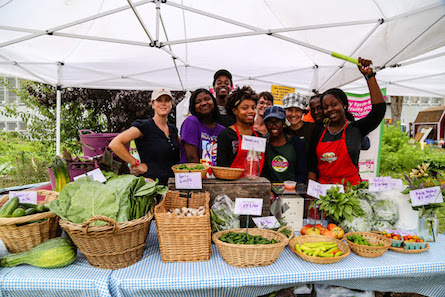
Ten NYC Eco-Schools are in the midst of an exciting collaboration with ioby, a crowd-resourcing platform for citizen-led neighborhood projects. Each school has chosen a worthy greening project in need of funding, ranging from a recycling program to a rooftop aquaponic greenhouse lab, and with ioby’s help, the funds are flowing in.
“When we surveyed our schools, both in 2012 and 2013, over 50% of teachers said that they lacked resources to implement green projects,” said Emily Fano, NYC Outreach Manager for Eco-Schools USA. “We’re thrilled about our partnership with ioby because they’re providing teachers and parent volunteers with the knowledge and skills they need to become effective fundraisers.”
Since mid-October, ioby has been providing representatives from each school with training on how to create their own crowd-funding campaigns; this has included a series of group coaching sessions by phone, tools and templates to work with, and individualized “office hours.”
“We were thrilled to work in partnership with NWF, serving these Eco-Schools with plans to make sustainability a bigger part of their schools,” says ioby co-founder and COO Brandon Whitney. “We often see that great leaders lack timely, right-sized funding to bring their ideas to life. ioby uses a digital platform and behind-the-scenes training to ensure that leaders get the resources they need, all while building a base of supporters along the way,” says Whitney.
ioby also boosted this partnership with a dollar-for-dollar match funded by the Johnson Ohana Charitable Foundation. All of this generosity has helped schools like PS84, an underserved public elementary school on Manhattan’s Upper West Side, raise money for green projects. PS84 has raised all but $57 of the $6,215 needed for one semester of learning in their Urban Roots Science Garden. This is particularly important for them, as the school has no budget for a full-time science teacher.
Another success story is The Youth Farm, in East Flatbush/Crown Heights, Brooklyn. The farm already serves as an outdoor classroom for the High School for Public Service, and now the farm managers want to provide this opportunity to the other four schools housed in the same building. They’ve raised 100% of the $14,985 they need to expand their reach and engage more students, particularly those who struggle most with traditional classroom education.
PS32, in the Gowanus section of Brooklyn, is hoping to jumpstart their recycling program with the money they raise. So far they’ve raised $2,969 of the $3,933 they need to buy recycling bins for all of their classrooms and common spaces, set up recycling stations and signs, and educate their students and staff about recycling.
The amount each school needs varies widely. Some are looking for as much as $46,000 to build rooftop greenhouses or aquaponic labs and others as little as a few thousand to start recycling initiatives or small gardens. But whether they’ve received $100, $1000, $10,000 or more, each school will keep the money they’ve raised, even if they don’t meet their goal; and they’ve learned some valuable fundraising skills along the way. That’s good news for everyone in the ioby/Eco-Schools program, which ends on December 20th, 2013.
Sam Judd: Jack gives back
By: nzherald
November 25, 2013
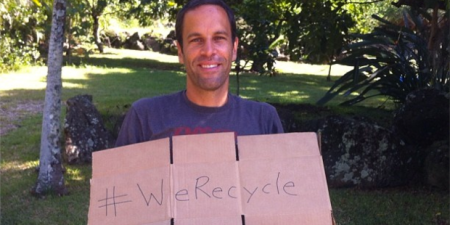
Original Source: The New Zealand Herald
Next week, the legendary surfing musician Jack Johnson is playing two shows at the ASB theatre in Auckland.
Jack Johnson isn't your typical rock star - he breaks the mould in terms of how the well-off behave.
After releasing multiple platinum albums to excellent critical acclaim, he lost the motivation to continue the hectic lifestyle of touring. Quite simply, he doesn't lead a lavish lifestyle - he prefers to surf, grow food and enjoy nature rather than blow cash being your archetypal rock star.
But then he remembered working with non-profit organisations and, realising how hard it is for them to raise funds, he embarked on a new journey that was to see him help grass roots organisations across the world.
In 2008 Jack and his wife Kim set up the Johnson Ohana Charitable Foundation, donating 100% of his tour profits to support organisations that engage individuals to make positive change in the areas of environment, art and music education.
They now partner with local charities at every tour stop, granting them matched donations when they come to town and valuable promotional space at the concerts too.
Not only that, Jack Johnson walks the talk. The 2010 To The Sea tour was one of the most sustainable concert concepts I have ever seen. The tour crew source their food locally, they refuse bottled water - instead opting for backstage water refill stations, and they aim for zero waste with an emphasis on composting and diverting waste from landfill.
Back in his Hawaiian homeland, the Johnson house is the first platinum LEED-Certified (Leadership in Energy and Environmental Design) building in Hawaii, it is constructed almost entirely from reclaimed timber, and features solar electricity generation, water catchment and an aeration treatment system that allows the sewage to be used on the garden. His environmental approach to building also extends to his studios.
He is an awesome example of how successful people can effectively make a huge difference to communities through leading by example and generosity to causes that are dear to his heart.
Compare this to Kanye West and Kim Kardashian who (my wife tells me) are reportedly intending to build a replica of the Downton Abbey mansion in Los Angeles just because they like the TV show.
I always found it interesting that as a general rule, when charities employ fundraisers to go door knocking, they don't go to the blue chip suburbs in cities, because the well off don't tend to give money away. They focus on areas where people know what it is like to need money - people who have been through that are much more likely to donate.
I guess you don't get rich by giving all of your money away, but having a lot of money is really quite different from leading a fulfilling life and knowing that you have done everything you can with your talents to help other people.
This is exactly what Jack did.
To commemorate the From Here To Now To You tour we are going to give Piha beach a good pre-Summer clean-up this weekend. We are meeting at 1:00PM at South Piha on Sunday the 1st of December. It happens to be New Zealand's inaugural National Surfing Day and if you pitch in to help you could win tickets to see the good man play live two days later!
For those of you who, having read this small part of Jack's mission to make the world a better place and want to start giving away some of your money to worthy causes, check out the One Percent Collective, who make it easy and fun to give away 1% of your income to local causes that you care about.
Jack Johnson Better Together With Eco-Green Ohana/Kokua Foundations
By: SAMARITANMAG
November 05, 2013
Original Source: Samaritan Mag
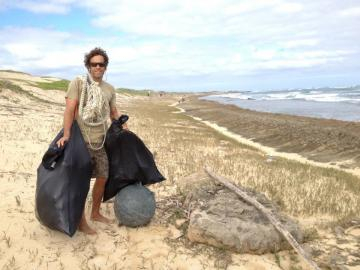
Jack Johnson views altruism and music as inseparable. While the Hawaii-based singer/songwriter and surf enthusiast may be best known to beer-glugging college kids for unhurried, sun-drenched acoustic anthems like "Better Together," “Upside Down” and “Sitting, Waiting, Wishing,” behind the scenes he is a fundraising superhero in flip-flops.
“For me it just came naturally and charity was something my wife Kim and I wanted to do as a couple,” a candid, laidback Johnson tells Samaritanmag from his Oahu homestead.
Together, the Johnsons operate two non-profit Foundations: the Kokua Hawai'i Foundation, which has promoted environmental education in the schools and communities of Hawaii since 2003, and the Johnson Ohana Charitable Foundation, created in 2008, which supports organizations worldwide that have strong community involvement and a solutions-based approach to environmental, art and music education. To date, Johnson reckons the two Foundations have raised some $25 million.
“We’ve met other people along the way that have really inspired us, like David Crosby and his wife (Jan Dance) and Neil and Pegi Young when we did the Bridge School Benefit — those using their marriage as a partnership that can use music for activism,” Johnson says.
Since 2008, Johnson has directed 100 percent of his touring proceeds to charity while aggressively pursuing green alternatives to traditional rock ‘n’ roll outings. His current theatre tour in support of his sixth studio album, From Here to Now to You, emphasizes “recycling, composting, and other waste diversion efforts to reduce the amount of waste headed for the landfill,” the singer writes on his website.
It also boasts a charity auction component that allows Johnson to raise even more money through fan-sponsored meet-and-greets, while shining the spotlight on local, hand-picked non-profits advocating for sustainable local food systems and plastic-free initiatives through the grassroots All At Once social action network.
What’s more, the Johnson Ohana Charitable Foundation has pledged to match every dollar donated to All At Once’s non-profit partners for this tour, up to $2,500 per group.
Then there is the plethora of charitable one-offs: a gig supporting Farm Aid in Pennsylvania last September; Johnson’s $50,000 donation to Hurricane Sandy relief in 2012; another $50,000 to GlobalGiving's Japan Earthquake and Tsunami Relief Fund in 2011 and so on.
That Johnson makes it all look so effortless — while continuing to churn out winning folk-pop songs – makes his efforts quite inspirational. There are always ways to make an impact, inspire change and be a business and charitable at the same time.
Jack Johnson and wife Kim co-founded two Foundations. “My wife has been a major influence on me,” Johnson offers when asked where this mile-wide philanthropic streak comes from. “I don’t want to say I blame it on her,” he laughs, “but it is a lot of work and it has become a big thing.
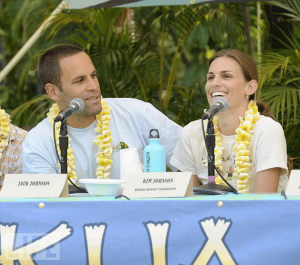
“A lot of times just before I go to bed I will say something and the next morning she will hold me to it and start making lists. So I take full responsibility for it — like when I say, ‘Hey, next time we tour let’s make a fundraiser out of it,’ she is really smart about it.
“But in some ways it’s been kind of nice that this has become a bit of a career, something I can put more time into. It’s nice to show my three kids what Dad does for a living — I play music to gather people together and use all that energy and finances to focus on things that are important to me.”
Environmental issues are cornerstone to Johnson’s agenda. His website lists multiple ways his tours reduce the carbon footprint using “sustainable biodiesel to fuel tour trucks, buses and generators throughout North America” for example, while encouraging fans to walk, bike or carpool to gigs.
“As part of a farm to stage catering program, Jack Johnson tour crew will work directly with local farms and purveyors across North America to source locally grown organic foods. All disposable cutlery and tableware is biodegradable,” the website adds.
Yet Johnson says that education — albeit with a focus on the environment — is at the heart of both the Johnson Ohana Charitable Foundation and the Kokua Hawai'i Foundation.
For example, through the Johnson Ohana Charitable Foundation, Jack Johnson’s 2010 To the Sea tour also partnered with over 220 non-profit partners to educate fans at every concert about plastic-free initiatives, sustainable local food projects, and other environmental issues.
“My wife was a teacher for four years — she has a Master’s degree in education — and I stole her away to be my tour manager,” Johnson says. “But she always wanted to get back into education. So I think the focus on education comes a lot from that.
“I went to public school in Hawaii, and so do my kids, and you see all the art and music programs being cut. So I felt that was an important thing to focus on. But environmental issues are always important.”
When they started the Kokua Hawai'i Foundation in 2003, it was focused on environmental education in the schools, he says.
“That was at a time when we didn’t have curbside recycling in Hawaii and we helped with a lot of groups that were kind of pushing for that. We started recycling programs in the schools — little microcosms of how it could work. That was a fun way to start the conversation.
“So a lot of the schools we had relationships with through the recycling then became involved in farm-to-school programs; connecting kids with their food at a young age, starting little gardens at the schools and taking them on field trips out to farms — things like that. Environmental work is important everywhere, but in Hawaii, it’s essential. Apart from the fact that I grew up here, 90 percent of our food is shipped in.
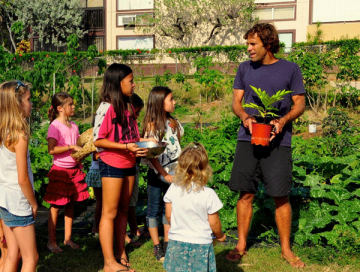
Jack Johnson brings students at Waikiki Elementary School an 'ulu tree from Ma'o Organic Farms as part of the Breadfruit Institude, National Tropical Botanical Garden's Plant A Tree of Life — Grow 'Ulu' project.
“We feel like if we can connect kids to their food when they’re young, they can tackle big problems as they get older,” Johnson continues. “How do we get more locally grown food in Hawaii? The impact of that is health, economy, and environment. Plus, so much of our farmland gets eaten up by development. People say, ‘Well, no one is growing food here so let’s just build a hotel.’ We need to get farmers on that land to grow food for Hawaii.”
Of the music charity aspect, referencing another focus of the Johnson Ohana Charitable Foundation, Johnson explains “music has done so much for me and my life. It brings me so much joy to play music with my kids. We are fortunate to have instruments lying around the house, to have that opportunity. So funding these programs where space is donated for after-school programs and kids can have instruments, it kind of reminds me of that movie, School of Rock.
“I’ve gone and jammed out with the kids and a lot of times if they know I am coming, they will learn one of my songs. And it’s great to see the smiles on the kids’ faces when they have a place to go to pick up an instrument after school.”
As for how the Foundations manage the $25 million raised to date, Johnson says, “It’s always a bit tricky to explain.
“Along the tour we give out money to local, non-profit groups in each town and that could be $2,500 to $5,000 to each group, and there might be five to 10 groups at each show. So by the end of the tour we’ll give out a portion of the funds raised, but the majority of funds are still left over. So we take those funds and put them into an endowment so each Foundation can live off the interest.”
According to its web site, the Johnson Ohana Charitable Foundation has distributed over $2 million to over 300 non-profits to date.
“So $25 million is how much we have put away for the Foundations to exist,” says Johnson, “and then what we give out per year has more to do with how we can make them sustainable financially. We give out a certain amount in grants every year. What we started realizing through conversations with our boards was ‘Where is this interest coming from and what are we doing with it?’
“More and more we are trying to focus on how we invest the money and making sure our investments match the mission of what our Foundations are trying to do. For instance, we don’t want to be making our interest from high-fructose corn syrup if we are focusing on child nutrition. The next step are these PRIs – project-related investments – which invests money into farms, for example, to make sure investments make sense with our mission.”
All of which ensures Johnson is bound for the history books as a supreme and highly effective example of a musician of conscience. Online charity watchdog group looktothestars.org – which monitors celebrity giving – lists no fewer than 23 additional organizations that have benefited from Johnson’s efforts, among them Amnesty International, Cystic Fibrosis Foundation, Red Cross, Live Earth and Heal the Ocean.
Yet asked whether he thinks colleagues in the performing arts do enough to help charity, Johnson is surprisingly equivocal.
“I don’t know the answer to that,” he says. “Obviously some people feel the responsibility. I do.
“I mean, I never imagined this is what I’d be doing with my life, so giving back just felt like the right thing to do, the best way to direct that energy, whether it’s the money you’re raising or just the number of people who come to the shows that we can direct towards groups doing good things in each town.
“At the same time, art is art. I can hear great music and I don’t necessarily care if that person uses their celebrity to promote something else.”
Johnson Ohana Charitable Foundation grant funds art class for Title 1 school kids
October 10, 2013
Original Source: Honolulu Academy
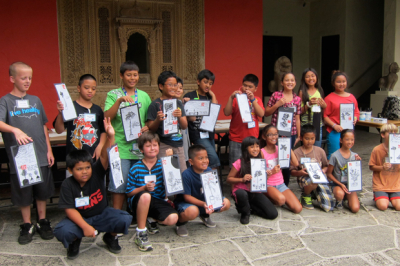
Last May, Kim Johnson, cofounder of the Johnson Ohana Charitable Foundation, and Jessica Scheeter, executive director of the foundation, toured the museum with our director of development Jessica Welch and outreach program coordinator Abbey Day. After giving the museum a grant for its Art to Go outreach program last year, Johnson and Scheeter requested a site visit to see the museum’s education programs in action.
“It was great to see artwork through the eyes of the kids, and then see the space where the hands-on workshops happen,” says Scheeter about the museum’s See Art Make Art school tours. “Kim Johnson was excited to get to visit the museum herself and learn more about its programs and the intent of See Art Make Art. In follow-up conversations with Jessica Welch, we learned that the museum was recommitted to reach out to Title 1 schools specifically.”
Welch applied for a second Johnson Ohana grant to fund the art-making portion of See Art Make Art tours for Title 1 students, and last month she received this email from Scheeter: “I am pleased to inform you that the Johnson Ohana Charitable Foundation has awarded the Honolulu Museum of Art a $5,000 mini-grant for See Art Make Art for Title 1 students. The board is excited about the work you are doing to provide hands-on art education and opportunities to youth in Hawaii.”
Welch is excited about the partnership. “It’s fun to work with such smart, committed funders. They really care about Hawai‘i and are hands on—they want to know the nitty gritty of our programs,” says Welch.
The Johnson Ohana Charitable Foundation, launched in 2008, supports programs the focus on environmental, art and music education, especially in Hawai‘i and on the West Coast. “We’re looking for groups that provide opportunities for children to engage with, in this case, art, in a hands-on way,” says Scheeter. “For this grant we were excited that the museum was showing commitment to reach more Title 1 students and schools. And we really liked that in addition to having the experience of visiting the museum and being exposed to the art they would be able to follow up with the hands-on art class so they could experience first hand different art themes and ways of creating art and thinking through the different mediums. It’s great that these kids get not only to see the art but also get their hands dirty afterwards and create art themselves.”
Why the emphasis on art programs? “Because schools often have limited resources and teachers feel time pressures, art sometimes gets left out, or is seen as nonessential,” explains Scheeter. “So having the museum offer this opportunity to take a field trip to the museum, have a chance to explore and learn about artists and art from many places opens up their world to so much more and lets them know that art is an important part of our communities and is something of value. These children deserve the right to explore art themselves.”
The Johnson Ohana Charitable Foundation’s board of directors, which includes Jack and Kim Johnson, reviews all the grants. “We’re looking to help out where we can, and tend to support free or low-cost programs to reach out to students that may not have these opportunities,” says Scheeter. “We don’t always get to make site visits, but we love to when it is possible. That way we get a stronger sense of the program and the team. “We like to develop a relationship with our grantees when our missions are closely aligned.”
Welch says that the foundation’s other areas of interest can help shape the museum’s education program. “It’s nice to make a connection with foundations that also have an environmental focus. It’s fun to see how we can connect the arts to environmental causes. [Kim and Jessica] got really excited about the prospect of the museum doing an exhibition of artwork using marine debris.” Other Hawai‘i organizations that have received grants from the foundation are the Hawai‘i Arts Alliance, Hawaii Youth Symphony, Honolulu Theatre for Youth, ‘Ōhia Productions, Hoa ‘Āina o Makaha, and Sustainable Coastlines Hawaii.
Welch says that the Johnson Ohana grant signals new developments in the museum’s education program. “It’s work we’ve always been doing, but over the past year we’ve been much more strategic, focused and integrated—it is a cross-departmental program that now uses the museum in a holistic manner. We’re poised to make a difference in a meaningful, focused way, and grants from organizations such as the Johnson Ohana Charitable Foundation help make it happen.”
About See Art Make Art and Working with Title 1 schools
See Art Make Art provides students with the opportunity to follow a docent-led museum tour—at the museum’s main location on Beretania Street and at Spalding House in Makiki Heights— with an art-making lesson taught by a professional artist. The teachers can select a themed tour such as Animals in Art, European and American Masterpieces, Asian Masterpieces, and Music through Art.
The art-making lesson that follows the tour adds a valuable hands-on project that reinforces lessons learned on the tour. Studies show that the average retention rate of students increase from less than 5 percent to more than 75 percent when they “do” rather than just listen. The art lesson costs $4 per student, a fee that is impossible for many students from Title I schools—where at least 40 percent of the student body comes from households living at or below the federal poverty line. These Title I children have the greatest need for art because there is no art in their schools and little opportunities to experience art in their community.
While the museum’s school tour program is successful in meeting desired outcomes through core curriculum, the proportion of Title I school we serve could be dramatically increased. Out of the 17,500 students who participate in the museum’s school tour program each year, an average of 5,000 are from 40 Title 1 schools. The Honolulu Museum of Art’s goal over the next three years is to double the participation of Title I public school students on its school tours, including the See Art Make Art Program.
To meet this goal, the museum has secured funding from the Atherton Family Foundation to add a Teacher Liaison position to our Education Department. This new staff person will collaborate with Title I teachers to ensure that museum programs meet their educational goals. The Johnson Ohana Charitable Foundation grant will make it possible for these teachers to register their students for See Art Make Art.
Read the blog post on the Atherton Family Foundation grant.